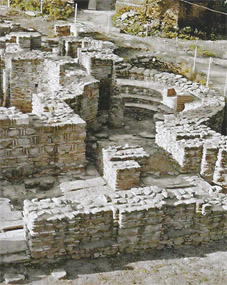Morodvis is the name of one of the most beautiful villages in eastern Macedonia. It lies at the foot of Mt. Plačkovica whose slopes glisten in more than twenty hues of green.
Random finds from the Early Roman period (1st to 4th centuries AD) have been discovered both in the village and in its vicinity. They speak of the existence of a small settlement with an urban and luxurious style of life. The name of the small town of Harmonia is recorded in Early Byzantine documents (5th to 7th centuries AD); it was situated in this part of Macedonia and it is very likely that it lies under the houses and yards of the present-day village of Morodvis.
It has been established with certainty that a Christian community lived here in the 5th century, while the faithful gathered in the temple discovered in the centre of the village known as Crkvište. This is a single-nave building with a baptisterium on the north side and a monumental underground vaulted tomb with Early Christian insignia. Around 855, the area of the river Bregalnica and the village of Morodvis was the site of the political and Christian mission of the Byzantine erudite and philologist Constantine the Philosopher (St. Cyril of Salonica) and it was precisely in this area that he composed the Slavonic alphabet.
During the reign of the Bulgarian Prince Boris Michael and his son Simeon, in the second half of the 9th century, Macedonia was annexed to the Bulgarian state; this marked the beginning of the building of numerous churches and monasteries. One such church was discovered above the Early Christian church in Morodvis whose foundations indicate that it was a domed cross-shaped structure. In the underground tomb, on its south side, relics of five saints with miraculous powers have been found. These are probably the remains of the five Early Christian martyrs from the city of Tiberiopolis (present-day Strumica). Their relics were transferred to Morodvis because of their miraculous properties, in order to attract pilgrims.
During emperors Samuil (976-1014) and Basil II (976-10-25), the town was known as Morobisdos, i.e., Morvisd. Morovisd was the most important administrative and political centre of present-day eastern Macedonia and an episcopal see. A cathedral church dating from the 11th century, one of the most harmoniously built three-nave churches of the Middle Byzantine period in Macedonia, has been discovered on the site of Crkvište. The marble mobiliary and the surviving fragments of the fresco painting that have been discovered are indicative of the highly ceremonial character of this building and its meaning which, with certain reconstructions, survived to the end of the 13th century. In mid-12th century, the great Arabic geographer, cartographer and botanist, Al Idrisi, recorded this town on the maps as Murumizdus or Formendos. He also wrote that it is “densely populated and stands on a hill. It has many vineyards and ploughed fields as far as the eye can see.” This is true of the village of Morodvis even today.
 Various objects that the population used in their everyday lives, and especially jewellery, have also been found in their graves. Roman, Byzantine, ‘Latin’ and Bulagrian coins have been discovered in this area, as well silver coins from Venice, Genoa and Ragusa (Dubrovnik).
Various objects that the population used in their everyday lives, and especially jewellery, have also been found in their graves. Roman, Byzantine, ‘Latin’ and Bulagrian coins have been discovered in this area, as well silver coins from Venice, Genoa and Ragusa (Dubrovnik).
In 1198, the Byzantine Emperor Alexius III issued a Privilegium to the Dodge of Venice Enrico Dandolo, which granted the Venetian merchants free trade with the province of Morovisd.
During the 13th century, in times of war, this region of Macedonia and the city of Morovisd changed masters seven times – Byzantium, the Latins, Bulgaria and eventually Serbia. The agony of the town is also reflected in the ruins that have been excavated. On the site of the demolished Episcopal church, towards the end of the 13th century a smaller and less lavish cross-shaped church with a dome was built.
In the second half of the 14th century, Morovisd was part of the principality of the Dragaš family, until 1395, when the Ottomans became its absolute masters. As local feudal lords and Muslims, they prayed in the mosque by the “old water fountain” in the village then known as the village of Morozda.
References
Ü.IvanovÝ, ”SÎverna Makedoni®, EpiskopiitÎ brÎgalni{ka i velbu`dska,” Sofi® 1906, 72-100.
K. Trajkovski, ”Srednovekovniot grad Morodvis vo Makedonija”, Trud ÃI V MUSA Kiev 1985, Moskva 1987, 89-93.
K. Trajkovski, ”Kultot na mo{tite vo Bregalni~kata dolina”, Folia Archaeologica Balkanica, in Honorem V.Bitrakova Grozdanova, Skopje 2006, 439-445.
